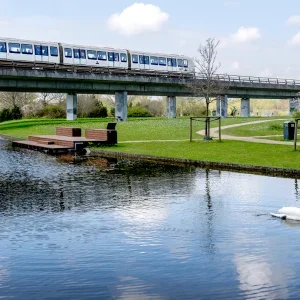Tunnelling is progressing smoothly on a 9.8km long water transfer tunnel for Hydro Quebec in Canada, thanks in part to the height of the jumbos.
EBC is constructing 8.3km of the tunnel using three Axera T12 DATAs, built by Sandvik Tamrock. The choice of machines was made because of their 13m reach.
“We wanted to meet Hydro Quebec’s requirement of a 13m tunnel height, but do it with only one pass to save time and money,’ Ms Guylaine Dubois, project manager for EBC, said.
The alternative would have been to construct the tunnel as a top heading and bench. The top heading would have been 8m high, drilled horizontally followed by a planned 5m thick bench that would have been drilled vertically.
The benefit of the single heading is the resulting shape of the tunnel, which will be unlined. This tunnel would normally have been horseshoe shaped with a flat invert, square corners, vertical side walls and an arched roof. However, horizontal drilling allows for a smoother profile on the walls and roof. The machines can create a tunnel with an oval shape above the invert, which means water flows with less resistance and turbulence resulting in more pressure at the turbines and better power generation.
Two jumbos have been drilling the 250MPa gneiss on the 13m high, 11m wide main tunnel since last summer. They are advancing at about 5.4m per round, every 13 hours. “I have about 115 employees working, and with two ten-hour shifts per day, we try to stagger shift times so that we get almost 24 hour production,” Dubois said.
The third machine is drilling the access tunnel. In the first two months after the start date, EBC had already completed more than 600m of the tunnel. Excavation should be completed by February 2004.
The other 1.5km is being constructed by contractor, Nielsen, using Atlas Copco machines.
The US$50M tunnel forms part of the Toulnustouc hydropower project river near Manicouagan in Quebec, Canada, which will produce 2.6 terawatthours annually.







